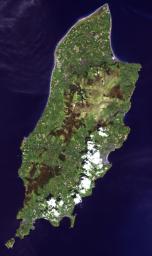The Isle of Man (also known as Mann) is a self-governing British Crown Dependency in the Irish Sea between Great Britain and Ireland. The island is not part of the United Kingdom, though the head of state is Queen Elizabeth II. Inhabited since 6500 BC, the island was influenced by Gaelic culture, settled by the Norse, was part of Scotland, and came under the feudal overlordship of the English Crown in 1399. The island's parliament, Tynwald, claims to be the oldest continuously existing ruling body in the world, possibly dating to the 10th century. The image was acquired May 1, 2001, covers an area of 29.4 x 49.5 km, and is located at 54.2 degrees north latitude, 4.5 degrees east longitude.
With its 14 spectral bands from the visible to the thermal infrared wavelength region and its high spatial resolution of 15 to 90 meters (about 50 to 300 feet), ASTER images Earth to map and monitor the changing surface of our planet. ASTER is one of five Earth-observing instruments launched Dec. 18, 1999, on Terra. The instrument was built by Japan's Ministry of Economy, Trade and Industry. A joint U.S./Japan science team is responsible for validation and calibration of the instrument and data products.
The broad spectral coverage and high spectral resolution of ASTER provides scientists in numerous disciplines with critical information for surface mapping and monitoring of dynamic conditions and temporal change. Example applications are: monitoring glacial advances and retreats; monitoring potentially active volcanoes; identifying crop stress; determining cloud morphology and physical properties; wetlands evaluation; thermal pollution monitoring; coral reef degradation; surface temperature mapping of soils and geology; and measuring surface heat balance.
The U.S. science team is located at NASA's Jet Propulsion Laboratory, Pasadena, Calif. The Terra mission is part of NASA's Science Mission Directorate, Washington, D.C.
More information about ASTER is available at http://asterweb.jpl.nasa.gov/.

 Planetary Data System
Planetary Data System












